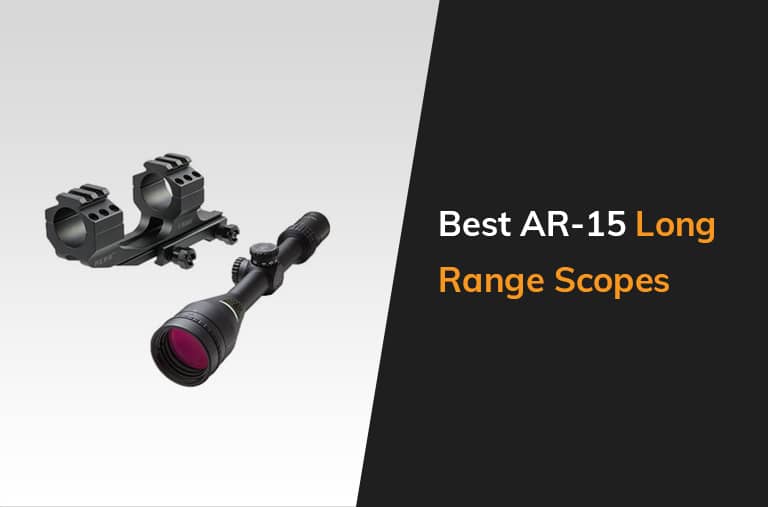At a Glance: best long-range scopes for AR-15
Comparison of The best long range rifle scopes
| PRODUCT | DETAILS | ||
|---|---|---|---|
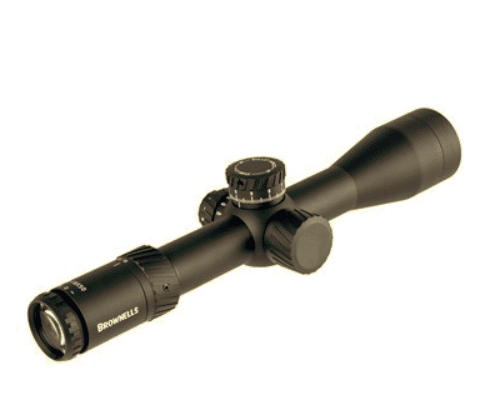
Our Top Pick
|
Brownells – Match Precision Optic 3-18x50mm Rifle Scope |
|
View Latest Price |
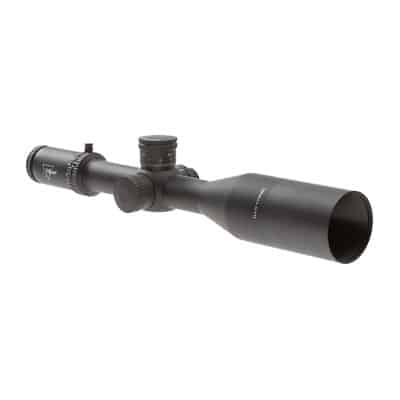
Our Top Pick
|
Trijicon -Tenmile 4.5-30x56mm Illuminated Long-range Scope |
|
View Latest Price |
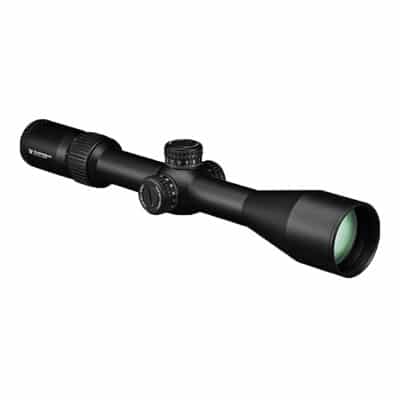
BEST BUDGET OPTION
|
Vortex Optics – Diamondback tactical 6-24x50mm FFP |
|
View Latest Price |
The AR-15 is America’s favorite gun, both for hunters and target shooters alike. Couple one with great optics you can expect accurate and precise long-range shooting. But if you just got your first AR-15 and never bought a long-range scope before, you’ll easily get lost in all the choices available on the market. Owning the best rifle scope is maybe the most important component in a precision weapon system. It is the connection between you, and the target; it is your fire control system. Your success in long-range shooting depends on the quality of the scope, on the quality of the scope’s mounts, and on how it’s installed on the rifle.
Our Guide to Buying the Best AR-15 Long Range Scopes
In this article, we are going to examine the desired features of a long range shooting scope and find the best suits our needs, in the myriad of options available. Before choosing the scope, you should have clear in mind the kind of shooting that you are willing to do. If you are going to compete in 1000yd competitions, you’ll need a completely different optic than the one you’ll need for long range hunting or military-style uses. Every different activity requires a different optic. One job, one rifle scope. If you are going to do different activities, or you are yet not sure, you can always strike a balance, but keep in mind that you’ll never get the maximum benefits.
- Best AR-15 Pistol Braces
- Best AR-15 80% lower receivers
- Best AR 15 uppers
- Best night vision scopes for your AR15
Brownells – Match Precision Optic 3-18x50mm Rifle Scope
First up is the Brownells 3-18x50mm Match Precision Optic rifle scope. This rifle scope is fully multi-coated, edge-blackened Japanese glass which provides max light transmission. Easily reset to zero with audible and tactile turret clicks. You have plenty of flexibility when it comes to elevation turret features which allow .5 mils of travel below the zero stop.
The reticle system is best for shooting methods requiring fast shots under a time constraint, or when fast follow-up shots are needed. The Brownells Match Precision Optic is the perfect optic for the long-range competitor. This optic is perfect for those budget is not unlimited and looking to perfect their one-of-a-kind build!
As with all products we sell, this scope is fully backed by our Forever Guarantee. Field of view is about 5.5 feet on 18x and 33.2 feet at 3x. The parallax, power, and illumination knobs have been reported by customers to be a bit stiff.
Pros
- Maximum light transmission
- Reticle and Turrets in MRAD for easy adjustments
- Waterproof
Cons
- Clicks on turrets are a little bit soft
- Sight picture is blurry at times
Trijicon -Tenmile 4.5-30x56mm Illuminated Long-range Scope
This is a great, durable long-range performance scope suitable for precision rifle shooters, long-range hunters, and tactical shooters. The body is made out of aluminum and offers all-weather protection. It features extra-low dispersion glass that delivers true colors for exceptional target definition. The lenses are fully multi-coated so there is no glare or loss of light. The objective lens is 56mm and offers outstanding light transmission even in low-light conditions. The generous 29.1 MRAD of elevation travel will get you to your desired distance. There is also a 14. 5 MRAD capped windage adjustment range with an optional windage restrictor. The crosshair reticle is easy to use and the illumination control has been upgraded with five red and five green brightness settings. Smooth, controlled magnification with a repositionable magnification lever that accommodates multiple platforms and firing positions. The easy-focus eyepiece diopter accommodates the shooter’s individual needs. The glass is extremely clear, even around the edges. It doesn’t lose any clarity at 30x as some cheaper scopes do. In addition, the parallax on this scope is very precise and useful for ranging as it has specifically labeled ticks out to 1000. The only downside is its weight.
Pros
- Durable
- All-weather protection
- Illuminated
- Fully multi-coated lenses
- 56mm objective lens
- Elevation and windage
- MRAD measurements
Cons
- Higher price range
- Quite heavy
Vortex Optics – Diamondback tactical 6-24x50mm FFP
The Vortex is a well-made optic, manufactured from aircraft-grade aluminum. It’s a pretty decent weight too, coming in at just under 15 ounces. The magnification is 4-12×, which provides a decent long-range view for hunting deer and game or some long-range precision shooting. The Vortex is pretty easy to mount and thanks to that low weight, it doesn’t impact rifle handling much. This scope has the enhanced elements you’d expert of a high-end optic but at an affordable price. It is built on a 30mm aluminum tube with a matte-black low glare finish. Adjustments are done in ¼ MOA. It features a glass-etched super clear reticle and well-balanced resettable and exposed turrets. It is very easy to sight in. The Vortex also comes with a BDC Reticle, a handy feature to compensate for holdover. The light collection is definitely something worth shouting about. It easily pulls in as much light as any higher-end optic I’ve used. I didn’t get the chance to use the sight in low light but I believe that the Vortex should be able to give a bright and clear image.
However, when you get into the higher power range (18+) or during low light conditions, the glass really starts to blur up which is kind of expected in this price range.
Pros
- Durable
- Matte-black finish for low glare
- Low weight
- Easy to sight in
- Great light collection
- BDC reticle
- Super affordable
Cons
- Starts blur up when at higher mag range
Kahles – K624i 6-24x56mm Scope FFP Moak Reticle
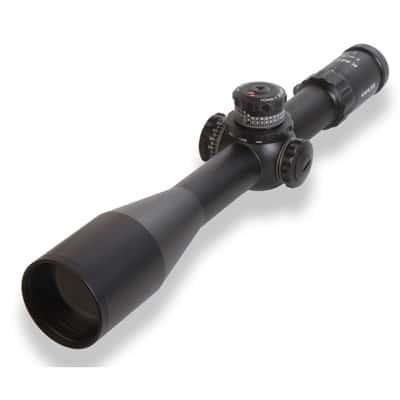
Kahles is Austria’s oldest existing optical manufacturer, dating back to 1898. Today, it is a sister company of Swarovski Optics. The company has focused its efforts on a new line of tactical, long-range rifle scopes. The Kahles K624i riflescope is an illuminated 6-24×56 mm scope with a 34 mm tube. It is known for its precision adjustments and optical quality, common among most expensive European scopes. It also brings some innovative features for the long-range shooter. It delivers extreme edge-to-edge clarity, more than 95% light transmission, and clear image at every magnification level. Its reticle is set in the front focal plane which ensures that the distance between the target and reticle size remains constant at all magnification levels. It is available with a left or right windage turret. The parallax adjustment is located under the elevation turret. That means the shooter can maintain position while using either hand to adjust parallax, which leads to the fast acquisition of multiple targets at varying distances. It has 26 mils of overall elevation adjustment in two rotations. For indexing, each click and line represents .1-MRAD (mil) for both elevation and windage. However, you can also get the Kahles K624i riflescope offered in an MOA version. There is a fast focus in the rear and the parallax goes from 50 meters to infinity.
Pros
- High-quality European scope
- Illuminated
- Precision adjustment
- Great clarity
- 95% light transmission
- Clear images at every magnification level
- Reticle in FFP
- Available in MRAD or MOA
Cons
- High price
Athlon Optics – Midas Tac 6-24x50mm Scope FFP Side Focus APRS2
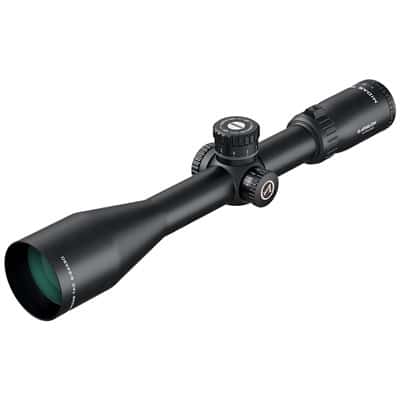
Athlon is one of the newest players in the sports optics industry. This scope is rather compact for its magnification range. It features a 50mm objective lens. Its length is 14.6″ with a weight of only 26.3oz. I am a big fan of lighter weight optics with objective lenses of this size with good light transmission aided by modern lens coatings. The Midas features a large uncapped 10 mil per turn zero stop elevation adjustment. The turret for adjustment is a little bit stiffer and has a higher rotation force between clicks which might cause over rotation at times. The windage knob is a little bit smaller with 10 mils per turn, marked 1-5 in each direction. It feels good and provides a nice compromise between a hunting design and a tactical design. The APRS2 is a typical mil hash reticle featuring a floating dot center and .2 mil increments. The turret adjustments are perfect in all respects. The windage and elevation are independent. No zero shift is affected by power change, parallax change, or diopter change. The power ring and euro style diopter are not the greatest. However, the parallax turret works great. The price is also quite nice.
Pros
- Significantly better quality than other scopes of this price range
- Properly sized reticle
- Smaller 50mm objective
- Lightweight, 26.3oz
- Full 10 mil/turn knobs
- Very simple effective zero stop that lets you chose travel below zero
- Good adjustment range, 25 mil
- Great price for a full-featured FFP/ zero stop scope
Cons
- No extras like scope caps or a sunshade
- Manual can be confusing for a beginner
Shmidt & Bender – PM II/P 12-50x56mm Scope Multi-Turn Turret FFP Illum. P4L Fine
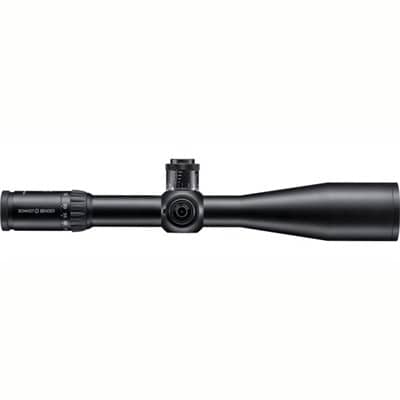
The 12-50×56 PM II/P is robust and durable scope perfect for you if you need higher magnification for shooting longer distances. The parallax adjustment permits you to focus on field targets at a distance between 10 meters and the practical range of your rifle. It has one of the highest magnifications available. The turrets can be configured in three clicks. Both elevation and windage knobs are measured in ⅛ MOA per 1 click but can be switched to ¼ MOA. The elevation knob is on the top and has small windows for checking which revolution/turn the turret is currently on. On the side of the elevation turret, you can see how many MOAs are in each turn. The windage turret also has small windows which give a color indication of whether you are turning left (yellow) or right (black). The reticle is on the first focal plane. However, a model with the reticle on the second focal plane is available as well. No illumination but a lot of light comes through the objective lens. The scope is waterproof to 25m and can withstand temperatures between -25C to 50C. For more info, check out this
Pros
- German quality
- Perfect for any weather
- Waterproof
- Easy adjustment
- Turrets with windows showing which turn you are on
- Measured in ⅛ MOA or ¼ MOA
- FFP Reticle
Cons
- High price
- No illumination
Sightron, Inc. – SVSS ED 10-50x60mm Scope 1/10 Moa Dot Reticle
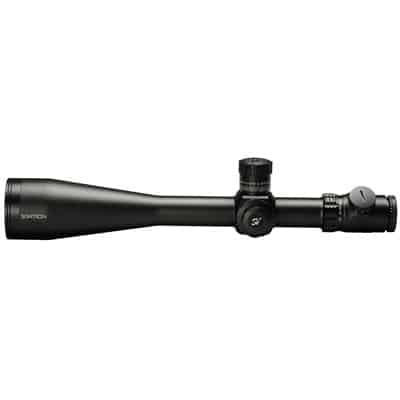
This scope is made by a Japanese company based in the USA that focuses on long-range scopes. This is a high quality, high-end scope. It is made from a one-piece 34mm tube. It is quite long, 16.5 inches. There are two knobs for adjusting the parallax, a big one and a smaller one. You can adjust from 13m to infinity with almost a full rotation for 100m. After you adjust the big parallax knob you can adjust the smaller one in finer increments. That allows you to adjust your parallax extremely precisely. The reticle is on the second focal plane with a small dot and crosshair. Elevation and windage turrets have a locking mechanism for tactical shooting. One-click is ⅛ MOA with a total travel of 70 MOA for elevation. The clicks on the turrets are crisp and audible. However, a zero stop is not included.
Pros
- High quality for a high price
- One of the best parallax adjustments on the market
- Crisp view
- Locking mechanism for the turrets
Cons
- No zero stop on the turrets
- Long and heavy
What’s The Effective Range of an AR-15 with a long-range scope?
According to U.S. Military standards, effective range means the range in which a firearm is effective and can reach a target. A scope will be viewed as long-range if it allows for accurate shooting within the AR-15’s effective range. The range of an AR-15 is a popular topic for a debate among shooters. According to the factory instruction manual, the AR-15 has an effective range of approximately 600 yards (550m).
In reality, the effective range of your AR-15 will depend on multiple factors.
- Weather conditions when you are shooting. The effective range will be longer on a dry clear day than when it is windy or raining.
- Is the shooter a beginner or a seasoned AR-15 marksman. The effective range for a beginner might be around 200 yards on a sunny day without wind. On the other hand, a shooting ace can precisely reach targets up to 1000 yards.
- What is the length of the barrel? AR-15s are available in at least three common barrel lengths.
- Carbine: up to 16 inches,
- Standard: 16 – 20 inches, and
- Target: at 24 inches.
Longer barrel length means that the round reaches a higher velocity due to the longer time the powder has to burn. The trajectory of high-velocity bullets is flatter over a long-range and has less drop. That allows for better accuracy over a distance. The effective velocity of a 16-inch barrel will be around 500 yards and for a 20-inch barrel close to 800 yards.
- What caliber are you using in your AR-15. The effective range of 500 yards applies to 5.56/.223 rounds. If you use heavier rounds like .224 Valkyrie, your effective range will be around 800 to 1000 yards.
What to Look for in an AR15 Long-Range Scope
Telescopic sights, commonly referred to as “scopes,” use a system of lenses to magnify the appearance of a target from a distance. Not surprisingly, this magnification effect on the user’s field of vision is beneficial for styles of shooting that require precision from a distance. While distance shots, to some degree, are capable with mere iron sights, adding a scope reduces some of the challenges involved. For the purposes of this article, we will decide that long-range means up to around 1000 yards as that is more or less the maximum effective range of an AR-15. That means that we will be looking at scopes that can handle 500-1000 yards.
There are, anyway, some common features that the optics must have, regardless of the activity. They are:
Ability to maintain zero: the scope must retain the adjustment from one shooting session to another, even after long periods of storage, and after transportation. If we lost the zero, we lost the ability to correctly set the adjustment. This is especially important in long range hunting and military style matches, since you don’t have sighting shots like in standard long range matches. High-end scopes, especially those that are long time proved on the hunting fields and battlefields, are virtually all capable of maintaining zero, but there might always be a mechanical defect. Mid-priced and low-priced scopes’ ability to maintain zero is always uncertain. It is also not easy to determinate if a scope is able or not to hold the zero, because a zero shift may be determinate not only by the scope’s mechanism failure, but also by the scope’s mounts poor quality or their improper installation, or even by imperfections in the rifle/stock assembly.
Adjustments accuracy and reliability: The rifle scope is an extreme precision tool. Its adjustments regulation are in the order of fractions of minutes of angles (MOA), or fractions of thousandths of radiant (mil or mrad). To meet this degree of accuracy, the internal mechanism must be itself very accurate. Sometimes we can find (even in mid and high priced scopes), that the values of the regulations are not exactly true; a “click” of adjustment doesn’t exactly correspond to the declared value. At short ranges, we’ll never notice the difference, but going farther with the distance the error will multiply, becoming a reason for misses. In addition, sometimes the mechanism can “lose some clicks” meaning that it doesn’t get all the amount of correction we set on the turret. To check if your scope “loses some clicks”, once your scope is perfectly zeroed, you rotate the elevation turret all the way up and then all the way down a couple of time. then you set it back to your zero and shoot again. If your shot doesn’t go in the aimed point, it means that you have “lost some clicks” during the dialing process. If that happens with a high priced scope, generally you can have it changed, because that’s not acceptable. To test the true click value, you can follow this article I wrote about the topic.
Adequate amount of total elevation adjustment: Trajectory have a lot of drop at the farthest distances, and this means that we need a lot of elevation adjustment to be able to aim at farthest ranges. For example, to shoot at 1000y with a 308 we’ll need about 39 MOA, or 11 MIL, of adjustment from a 100y zero. The longer the distance, the more the needed elevation. When we select the scope, we must be sure that the total elevation adjustment meets our needing. Keep also in mind that when we zero our rifle, we usually “burn” half of the total excursion so, if a scope is declared of 80MOA of total adjustment, we’ll be able to utilize only about 40MOA. Consider also that it is not good practice to go work near the adjustments end. The total elevation adjustment of a scope is dictated by how the internal mechanism is engineered, and is declared by the manufacturers. Generally, scopes with a larger tube diameter have a greater total amount of adjustment. If the total adjustment of our scope is not enough, we can fix this problem mounting the scope on an inclined base, or with particular scope rings. But we’ll discuss of this in the related articles.
How Scopes Work
Telescopic sights generally have a combination of curved lenses and reflective surfaces within a metal sleeve. The shooter looks through the ocular lens (smaller, and of lower magnification), and the objective lens at the scope’s far end increases magnification. Some telescopic sights are fixed in the amount of magnification they can provide. Others are variable.
The “power” of the magnification of any particular scope is usually denoted like so: optical magnification x objective lens diameter (for fixed magnification optics), or minimum magnification – maximum magnification x objective lens diameter. For example, the Leupold scope shown below is denoted 2-12×42. This means the lowest magnification is 2x larger than the naked eye, minimum, with a maximum of 12x, and the objective lens is 42mm in diameter (lenses are often measured in metrics, rather than the US customary units).
Basic Scope Terms
Fixed or variable
Fixed scopes are of less complex construction. Simple construction equals more reliability, and that’s the reason why the military have used fixed scopes for decades. Modern construction processes have increased the reliability of variable optics however when you are on a budget, you may consider to get a fixed scope since they are cheaper in respect of their variable counterpart of similar quality. On the other hand, variable scopes allow you to fit a wide range of “jobs”, since you may need to change magnification for various reasons, such avoid mirage distortion, increase field of view, increase light transmission for twilight (not the movie) shots, or decrease wobbling perception during off-hand or unsupported shooting.
Magnification
The amount of magnification we are going to need is in the function of the type of shooting, the distance, and the target size. Longer distances and smaller targets require more magnification. More is not always better, since with higher magnifications you amplify optical imperfections in mid and low priced scopes, sometimes compromising your ability to aim accurately, thus the higher the magnification, the better must be the optic. Moreover, optics with more magnifications are also generally bulkier and heavier. From my experience, for target shooting at static distances (i.e. 1000y matches), varmint hunting, and extreme long-range shooting, 20-25X scopes work just fine. For military-style shooting, at paper targets or gongs at variable distances, or for big game hunting at long (but not extreme) range, 12-14X are more than enough.
Tube diameter
The scope’s tube is the cylindrical part of the scope between the eyepiece and the turret and between the turrets and the objective cone. Its diameter is indicated in millimeters (the diameter of 25mm is indicated as 1”), and it is a crucial parameter for the selection of a scope. Wider tubes allow more light transmission and, generally, a higher amount of adjustment. In the past, almost all the rifle scopes on the market came with a 25mm (or 1”) tube. Today, many brands offer 30mm tubes with some offering 34mm and 40mm (like the IOR Valdada).
Front lens (or objective) diameter
Larger front lenses allow more light in the scope, meaning that we should be able to shoot under lower light conditions. I’ve written “we should” because in reality light transmission is also in function of other variables like the light transmission capability of the lens crystal and the scope’s tube diameter. We can obtain a reference value of the low light capability of a scope, the so-called “exit pupil”, dividing the front lens diameter (in millimetres) by the magnification value. For example,if we have a 10×40 scope we will have an exit pupil of 40/10=4mm. Here again, more is not always better. Our pupil can receive only a certain amount of light, and that amount of light decreases with age. In addition, high exit pupil values are useful for shots in low light conditions, but when you are utilizing the scope in standard light conditions (i.e. in the middle of the day), the great amount of light that you receive can prematurely strain your eye. Wider objectives also force you to mount the scope higher over the barrel line, forcing you to stay higher with your head and increasing the errors due to rifle canting. From my experience, for hunting purpose, where you are likely to shot in low light conditions, a good 50mm is enough. For target shooting, a 50mm is still good but even a 40mm will do the job.
Reticle types
The reticle marks the point of aim in your sight picture. There are different types of reticles (also called cross-hairs) for different shooting purposes. To name a few, dot reticle, German reticle, duplex reticle, illuminated reticle, etc. BDC and mil-dot reticles let you, for example, adjust your elevation and windage with preset dots so you don’t have to adjust the turret every time you use your scope.
Focal plane
A front focal plane reticle is optimal for long-range shooting. The focal plane the reticle is on determines the size of the reticle when the scope is zoomed in. There are two focal plane options:
- The front focal plane (FFP) means that the size of the reticle will appear to change as the scope’s magnification is changed.
- The second focal plane (SFP) means that the reticle will appear to stay the same even under magnification.
Turret and MOA
Minute of Angle (MOA) is a unit of angular measurement meaning one inch off target at a hundred yards. Generally, high-power scopes can make adjustments at a fraction of MOA per click. The turret adjustment should be easily accessible, smooth, and audible for precise long-distance shot calibration.
Target turrets
All long-range scopes have windage and elevation knobs. These help you to sight in the optic at a set distance. Most turrets are, however, small and have a low profile. That makes them hard to use.
For long-distance shooting, a scope with target turrets can be a major asset. Target Turrets are tall, easy to turn, make tactile or audible clicks, and have external markings to represent MOA or mil (MRAD).
Field of view
also indicated with the acronym FOV, is the amount of view that you can see through your scope at a given distance. It is indicated in ft@100yds (feet at 100yds) or m@100m (meters at 100m). The amount of FOV a scope is determined by the internal construction of the eyepiece. It is an important parameter to consider when choosing a scope for hunting or dynamic shooting purpose, since a wider field of view may help in tracking a moving target as well as spotting multiple targets in the same area and eventually following their movements.
Eye relief
When watching through a telescopic sight, there is only one distance, from the rear lens, from which the eye can see a full perfect picture. That distance is the eye relief. Its value is expressed in inches or millimeters, and for rifle scopes, it is generally in the range of 3 to 4 in. Generally, it is related to the scope’s magnification, with higher magnification scopes having shorter eye relief, but that’s not a rule. When choosing the scope, eye relief may be taken into consideration only when the scope is mounted on rifles with heavy recoil, since a short eye relief could be dangerous for the shooter. To be honest, a difference in eye relief of 1” is not that big difference. To avoid the famous “scope kiss”, a proper technique helps a lot more than that inch.
Lens quality
There is a vast range of telescopic sights available, not only with varying levels of magnification and lens diameter, but also differing coatings for the glass (both to protect the glass itself, and to alter the way the light enters the optic, which could improve clarity and color, levels of adjustment for windage and elevation, and there are even some scopes that include electronic elements that assist in ballistics calculations.
Most high-quality scopes have high-quality coated lenses. Fully multi-coated lenses are the best choice. The optical coatings reduce the loss of light due to reflection, minimize glare, maximize light transmission through the scope, and protect the lens from scratches.
Here are the different types of coated lenses:
- Coated with at least one layer on at least one lens,
- Fully coated – there is a single coat on each air-to-glass lens,
- Multi-coated – the scope has a single coat on most air-to-glass lenses with multiple coats on at least one lens,
- Fully multi-coated – all air-to-glass lenses have multiple layers of coating.
Minute of Angle and MRAD
MOA and MRAD/mil are two types of measurements used for sighting in a rifle. Sighting in or zeroing means aligning the scope with the point of impact, allowing the shooter to place bullets predictably and precisely at a given distance. Both systems are equally effective, however:
- MOA is used more in countries with imperial measurements, most ballistic tables are in feet and yards, and ¼ MOA adjustments are more precise than 1/10 mil adjustments.
- MRAD (Milliradian) are metric and easy to calculate. Also, the U.S. Military and high-end equipment use MRAD.
If you are more comfortable with imperial measurement then MOA might be more of your jam and vice versa. MOA is equal to 1.047 inches at 100 yards while mil is equal to 3.6 inches at 100 yards.
Parallax
Parallax is an inconsistency in the view that you see when you look through your rifle scope. It causes the reticle to move across the target as you shift your eye position. This means the reticle is not accurately reflecting where your rifle is pointing. Parallax is noticeable in higher magnification and it occurs when the projected image is too far away from the cross-hair in the scope.
Parallax adjustment: When you need extreme accuracy, you want to avoid parallax error, so parallax adjustment is essential on a long range scope. The parallax adjustment can be on the objective, or on a side knob. If it is on the objective, it’s very hard to regulate it from the shooting position, so if you don’t shoot at a fix distance it’s better to have it on the side knob.
There are ways to adjust for parallax:
- Place your AR-15 in a shooting stand or anchor it to a shooting table,
- Adjust the parallax adjustment ring to be as close as possible to the range you’re shooting out to using a quick guess at the distance from the target and dial it in from there,
- Aim down your scope and adjust your eye position slowly.
- Pay attention to the crosshair’s position on the target.
- If you’re seeing the crosshair move as you move your eye, you’re experiencing parallax.
- If you move your head to the left slightly, pay attention to how your crosshair moves. If it moves to the left on the target, it means your image is too far in front of the reticle and you need to increase the distance of the adjustment. If the reticle moves to the right on the target as you move your head left, you need to decrease the distance adjustment.
Benefits of Investing in a Long-Range Scope for your AR-15
Long-range target shooting has enjoyed increased popularity recently which means the number of long-range scopes has increased as well. If you want to shoot precisely at a long-range, you will need a quality rifle, precise ammunition, and a high-performance optic. There is just no way around it. I know, rifle scopes are not the cheapest but having a high-quality rifle scope will help you to become a great long-range shooter with precise and accurate shots. This skill will come in handy when you decide to get into hunting or try out a shooting competition.
How to mount a long-range scope on your AR15
Generally, people use two types of mounts for long-range precision shooting. Both are very easy to use and neither is better than the other. They simply offer shooters different options since they have two distinct roles. It is always important to examine your firearm to choose one or the other mounting system. Always weigh your options.
- A single-piece scope mount is two scope rings mounted to a single base.
One-piece scope mounts are:- Very rigid,
- Durable,
- Perfect for high recoiling systems,
- Not suitable for bolt action rifles,
- More pricey than two-piece mounts.
There are a few different reasons why they are typically used on modern semi-automatics:
- They can push your scope forward, allowing the bell of the scope to sit above certain handguards.
- They allow proper clearance for a long-range scope.
- Two-piece rings are much lighter than a one-piece mount but still very durable.
Other important characteristics include:- Suitable mainly for bolt action rifles,
- Need to be aligned properly,
- Can stay on the scope and be moved to a different firearm, and
- Great affordability.
You will need some tools to mount your long-range scope on your AR-15. These include:
- A torque wrench is the most important tool for precise mounting of your scope. The screws and the scope rings should never be overtightened. A proper torque wrench will click when screws are properly tightened.
- Loctite or Sure Thread can secure the bolts in place.
- A lapping bar and pin set, screwdriver and bits, and a modular level system will make sure the gun is leveled with the scope.
The following steps should be followed when mounting your scope:
- When your rifle is clear, get rid of any grease on your rifle’s rail as well as the mount and scope.
- Position the one-piece mount on the top rail (place the cantilever mount’s base just above the magwell/for non-cantilever mount’s place it further forward).
- If you are using ring mounts, then adjust the rings individually to fit the scope’s size.
- Put your scope on the mount and shoulder your rifle. Look through the scope, move it backward or forward on the rail until you see a full clear picture through the scope.
- Fix the mount to the rifle.
- Place your rifle into a vice and with help of the bubble level check that the mount is balanced in all directions.
- Set your scope inside the mount again to verify your eye relief.
- Place the top caps on and tighten the screws once you find the perfect position.
- Use a level to see if the scope is positioned right from all angles.
- Unscrew each top cap screw and add a drop of blue Loctite on the threads. Then screw back down. Do not over-torque it as it might make the scope shift. Repeat with each screw.
To learn more about how to mount a long-range scope on your AR15
Best Long Range Scopes – The Winner is…
We have reviewed seven long-range scopes in this article. Based on their price they can be divided into two groups:
- The higher-end options including
- Trijicon -Tenmile 4.5-30x56mm Illuminated
- Kahles – K624i 6-24x56mm FFP
- Shmidt & Bender – PM II/P 12-50x56mm FFP Illuminated
- Sightron, Inc. – SVSS ED 10-50x60mm
- The lower-end, including
- Burris – AR 5.56 4.5-14x42mm Adjustable Objective Scope
- Vortex Optics – Diamondback tactical 6-24x50mm FFP
- Athlon Optics – Midas Tac 6-24x50mm FFP Side Focus Aprs2
The first group of high-end and high-priced AR-15 long-range scopes presents amazing optics. They all are made of very durable materials, most of them waterproof and suitable for all weather conditions. On the other hand, most of them are also long and heavy. My favorite is the Kahles scope. It has amazing lenses, easy precise adjustment, top-notch clarity and it is illuminated.
The other group, in the lower end of the price range, still offers decent long-range scopes for your AR-15. However, using them at high magnification may cause a blur. Some of them are also quite heavy. My favorite from this group is the Athlon Midas scope as it is small and lightweight and it has better optics than most competitors at this price range.

